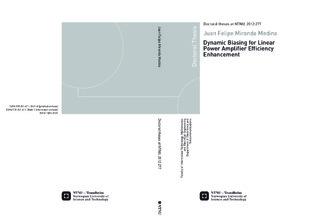| dc.contributor.author | Medina, Juan Felipe Miranda | nb_NO |
| dc.date.accessioned | 2014-12-19T13:48:18Z | |
| dc.date.accessioned | 2015-12-22T11:47:46Z | |
| dc.date.available | 2014-12-19T13:48:18Z | |
| dc.date.available | 2015-12-22T11:47:46Z | |
| dc.date.created | 2013-01-30 | nb_NO |
| dc.date.issued | 2012 | nb_NO |
| dc.identifier | 602057 | nb_NO |
| dc.identifier.isbn | 978-82-471-3868-7 (electronic version) | nb_NO |
| dc.identifier.isbn | 978-82-471-3867-0 (printed version) | |
| dc.identifier.uri | http://hdl.handle.net/11250/2370677 | |
| dc.description.abstract | Spectrum is an indispensable and scarce resource in modern communication systems. Reduced hardware complexity is therefore traded for bandwidth-efficient modulation that increases the signal’s peak-to-average power ratio (PAPR).
For applications requiring high linearity amplification at microwave frequencies, class-A and -AB power amplifiers have been the traditional choice. However, due to the large PAPR of the modulated signals, they must be operated at several decibels back-off to comply with linearity requirements. Though class-A/AB amplifiers offer descent efficiency at peak envelope power, efficiency decays rapidly with input power back-off. The designer is seemingly left with an inevitable linearity– efficiency trade-off. Though there are several alternatives around the problem, in the context of point-to-point radios the challenge is to find low-cost, reliable solutions that are independent of carrier frequency and manage large bandwidths (e.g., 40 MHz) for moderate output powers (i.e., not larger than 10 W).
It is therefore that dynamic biasing—the joint variation of input and output biases following envelope power—is attractive. Following envelope power instead of envelope amplitude and varying also the input bias makes DB substantially different from envelope tracking (ET). Varying the output and input biases as first and second order polynomials of the input power, the bias bandwidth can be controlled to be only twice and four times the RF bandwidth, respectively. Bias bandwidth in a typical ET system would be at least twice as large. This dissertation specifically addresses the problem finding the polynomial coefficients for bias variation, first through simulation methods, and then through direct measurement on different technologies (an MMIC HBT transistor, a discrete GaAs amplifier, and a discrete GaN amplifier). The dynamic biasing problem is formulated mathematically and solved using random search optimization, for which a multi-objective cost function and a linearity measure—different from least square error—are introduced. The effect of output matching on the linearity of the amplifier, and the inclusion of digital predistortion without affecting bias bandwidth are also considered. The results from this research study show that dynamic variation of the input bias alone can significantly improve linearity—a low-complexity, low-cost solution due to the low current levels at the input—. The largest benefits in efficiency are certainly obtained from output bias variation. Though it may adversely affect linearity if used alone, in many cases full dynamic bias (both at input and output)is a win–win combination both in regards to linearity and efficiency. The technique is also attractive because the transistor can be biased higher at peak power if the PAPR of the signal is large, and hence higher average output power can be obtained than with static biasing. | nb_NO |
| dc.language | eng | nb_NO |
| dc.publisher | NTNU | nb_NO |
| dc.relation.ispartofseries | Doktoravhandlinger ved NTNU, 1503-8181; 2012:277 | nb_NO |
| dc.title | Dynamic biasing for linear power amplifier efficiency enhancement | nb_NO |
| dc.type | Doctoral thesis | nb_NO |
| dc.contributor.department | Norges teknisk-naturvitenskapelige universitet, Fakultet for informasjonsteknologi, matematikk og elektroteknikk, Institutt for elektronikk og telekommunikasjon | nb_NO |
| dc.description.degree | PhD i elektronikk og telekommunikasjon | nb_NO |
| dc.description.degree | PhD in Electronics and Telecommunication | |
